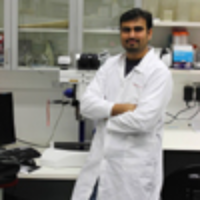Nanoencapsulated Extracts from Leaves of Bauhinia forficata Link: In vitro Antioxidant, Toxicogenetic, and Hypoglycemic Activity Effects in Streptozotocin-induced Diabetic Mice
Published on: 5th September, 2024
In this study, we evaluated the assessed the hypoglycemiant, toxicogenetic and genotoxic effects of nanoencapsulate extracts of Bauhinia forficata Link. Phytochemical evaluations of extracts were carried out, as well as the evaluation using HPLC-MS and of antioxidant capacity in vitro. DM2 was induced in mice with streptozotocin and extracts were given orally for 28 days. That dried extract from infusion (ESIN) had a higher rate of bioactive compounds compared to the dried extract from decoction (ESDC), and higher antioxidant capacity. Glucose levels decreased from 77.26% to 57.79% and 45.15% after supplementation with ESIN (200 and 600 mg/kg/day) and ESDC (600 mg/kg/day), respectively, when compared to the diabetic group treated with metformin (600 mg/kg/day) (21.53%), with an improvement in the glycemic response e recovery of pancreatic β cells. Thus, our study has shown that these extracts exhibit hypoglycemiant activity, with a beneficial effect superior to metformin, as a result they could be considered as potential therapeutic agents for application in pharmaceutical formulations in the treatment of DM2.
Emerging Trends in Sports Cardiology: The Role of Micronutrients in Cardiovascular Health and Performance
Published on: 6th September, 2024
Micronutrients are critical components of an athlete’s diet, affecting both performance and cardiovascular health. This review summarizes current studies on the importance of micronutrients in sports cardiology, focusing on their effects on energy metabolism, antioxidant defense, and cardiac function. Key findings emphasize the relevance of micronutrient sufficiency in improving athletic performance and avoiding long-term health issues linked to strenuous training programs. Micronutrients like B vitamins help energy generation pathways, while antioxidants like C and E reduce exercise-induced oxidative damage. Minerals like magnesium and iron are important for muscle function and oxygen delivery, which are required for endurance and recovery. Effective nutritional practices include balancing food intake and, if required, supplementing under medical supervision to address individual needs and enhance performance results. Future research paths will focus on individualized nutrition techniques based on genetic and metabolic profiles, allowing for more precise food recommendations for athletes. Collaboration between sports medicine and nutrition disciplines is critical for establishing evidence-based practices and improving cardiovascular health in athletes.
Neuroprotective Effect of 7,8-dihydroxyflavone in a Mouse Model of HIV-Associated Neurocognitive Disorder (HAND)
Published on: 18th September, 2024
Treatment for HIV-associated neurocognitive disorders (HAND) remains elusive. 7,8-dihydroxyflavone (DHF), an analog of brain-derived neurotrophic factor (BDNF) and a high-affinity TrkB agonist, has been proposed as a viable therapeutic alternative to BDNF in crossing the Blood-Brain Barrier (BBB) and promoting growth, differentiation, maintenance, and survival of neurons. Here, we expand on our previous study investigating the therapeutic role of DHF on the cortical and hippocampal brain regions of the Tg26 mice, an animal model of HAND. We detected increased immunoreactivity for ion channels (SUR1, TRPM4) and the water channel aquaporin-4 (AQP4), suggesting an ionic and osmotic imbalance in the brains of Tg26 mice. Tg26 mice also exhibited loss of synaptic stability (SYN, SYP) and nicotinamide metabolism (NAMPT, SIRT1) that were associated with astrogliosis. Furthermore, Tg26 mice demonstrated increased iNOS and reduced HO-1/NRF2 expressions, implicating increased ER and oxidative stress. DHF treatment in Tg26 mice reversed these pathological changes. These data suggest crosstalk among TrkB, Akt, and related transcription factors (NF-κB, STAT3, and NRF2) as an underlying mechanism of Tg26-associated pathology in the brain. Finally, taken together with our prior study, these results further highlight a therapeutic role of DHF in promoting neuroprotection in HAND that may be applied in conjunction with current antiviral therapies.
Survival of Free and Encapsulated Probiotics in Healthy Gummy Candy as a Carrier for Probiotic Capsules
Published on: 1st October, 2024
Probiotic gummy candy is an innovative food that can be used as a carrier to deliver probiotics. This study aimed to manufacture healthy gummy candy (HGC) as a carrier for probiotic capsules. The ingredients' effect on the viability of probiotic capsules and free cells was evaluated for 48 days under refrigerated conditions. Also, the textural properties, overall acceptability of products, and physicochemical properties were tested. The encapsulation probiotics in sodium alginate and chitosan provided a high efficiency of 88.16%. At the same time, the encapsulated cells-based HGC (HGC-C) had higher counts of probiotics than free cells-based HGC, and it remained above the 3 log CFU/g at the end of the 48-day storage period in HGC-C, while the free cells reached zero at 30 days. The HGC product showed a low hardness value and high antioxidant capacity as well as, and the colour coordinates for the product showed more yellow, with an intense red colour. Using mango pulp and probiotics in gummy candies is an innovative and viable alternative to the confectionery industry; therefore, combining fruits as a source of prebiotics and probiotic bacteria could be a promising formula for probiotics gummy supplement preparation.
Antimicrobial, Antioxidant Activity of Ethyl Acetate Extract of Streptomyces sp. PERM2, its Potential Modes of Action and Bioactive Compounds
Published on: 18th November, 2024
Background: Microorganisms belonging to Streptomyces sp. are Gram-positive bacteria known for their unsurpassed capacity for the production of secondary metabolites with diverse biological activities. The aim of this study was to evaluate the antimicrobial and antioxidant properties of ethyl acetate Streptomyces sp. PERM2 extract, its potential modes of action and bioactive secondary metabolites.Results: The ethyl acetate PERM2 extract showed antimicrobial activity more pronounced on both Gram-positive and Gram-negative bacteria and fungi with a Minimum Inhibitory Concentration value (MIC) of 0.5 mg/mL and Minimum Bactericidal Concentration (MBC) of 2 - 4 mg/mL against bacterial pathogens. MIC value against pathogenic fungi was 2 mg/mL and Minimum Fungicidal Concentration (MFC) of 0.01 - 0.05 mg/mL against pathogenic fungi. PERM2 crude extract showed the ability to inhibit bacteria cell wall synthesis at 0.5 and 1 MIC. The extract was found to possess dose-dependent 2,2-Diphenyl-picrylhadrazyl (DPPH) free radical scavenging and Ferric reducing activity. The gas chromatography-mass spectrometry (GC-MS) analysis revealed the presence of three major compounds identified as 9,12-octadecadienoic acid (Z, Z) (29.75%), tridecyl trifluoroacetate (24.82%) and 1-(+)-ascorbic acid 2, 6-dihexadecanoate (22.34%). The liquid chromatography-tandem mass spectrometry (LC-MS/MS) analysis revealed the presence of 22 non-volatile metabolites in PERM2 extract and only the compound 3, 30-O-dimethylellagic acid was identified. Conclusion: The results of this study indicate that ethyl acetate Streptomyces sp. PERM2 extract possesses antibacterial, antifungal, and antioxidant activities; inhibits bacteria cell wall and protein synthesis; and contains significant bioactive secondary metabolites which could be used as an alternative to multi-resistance antibiotics.
Plant growth, Yield and Leaf Nutritional value of Jute (Corchorus olitorius L.) as Influenced by Banana Peel levels under Salt Stress conditions in Coastal region of Cameroon
Published on: 30th November, 2024
In the world, millions of hectares of cultivated land are affected by salt, making salinity a major constraint for plant production. The effects of different levels of banana peel on growth, yield, and chemical changes of jute (Corchorus olitorius L.) under salt stress were examined herein. Response of jute to applications of different levels of banana peel (5, 10, and 15 t ha-1), as well as water irrigation salinity at 50, 100, and 200 mM NaCl were evaluated under greenhouse conditions. The outcome uncovered that salinity caused significant reduction of plant growth and yield parameters, chlorophyll (at 21.6%), LRWC (at 18.9%), P (at 57.1%) and K (at 45.4%) content, while MDA content (at 351.8%), Na (at 266%), soluble proteins (70.2%), total phenolic (at 23.4%) accumulation showed an increase from 0 to 200 mM NaCl without BP application. The banana peel treatments (at 15 t ha-1 under 200 mM NaCl) diminished significantly damaging effects caused by salinity via a reduction in the Na (at 28.4%), total soluble sugars (at 17.8%), total flavonoids (at 20.1%), which enhanced number of leaves per plant (37.1%), plant height (at 19.8%), leave yield (at 41.4%), LRWC (at 12.8%), Mg (at 24.2%) and reduced the MDA content (at 20%), presenting a favorable effect in reducing the oxidative stress that emerged from salt stress. It could be concluded, that the application of 15 t ha-1 of BP was superior in promoting plant growth, yield, and nutritional quality than others under control and in the saline soils in this study. BP at 15 t ha-1 had a more reduced damage of salt stress effect on growth, yield, nutritional value, and use efficiency.
In vitro, Anti-oxidant, and Anti-inflammatory Activity of Kalanchoe pinnata
Published on: 24th January, 2025
Kalanchoe pinnata is a widely recognized medicinal plant known for its antioxidant and anti-inflammatory properties. This study explores its in vitro antioxidant and anti-inflammatory activities, highlighting its potential for pharmaceutical and biomedical applications. The research innovatively assesses its bioactive components using DPPH radical scavenging, nitric oxide inhibition assays, and phenolic content analysis. Results demonstrated significant antioxidant activity with IC50 values comparable to ascorbic acid, along with notable anti-inflammatory effects via nitric oxide inhibition. These findings emphasize Kalanchoe pinnata’s potential as a source for developing antioxidant and anti-inflammatory therapeutics. Further investigation into bioactive compound isolation and mechanistic pathways is recommended to clarify its pharmacological efficacy.
Insights into the Complexity of Paradoxical Antioxidants Behavior. And the Reasons for it’s almost Zero or no Effect on Stroke
Published on: 31st January, 2025
Antioxidants are groups of compounds that neutralize free radicals and Reactive Oxygen Species (ROS) in the cell [1]. Antioxidant activity in food and beverages has become one of the most interesting features in the science community. These antioxidants provide protection against damage caused by free radicals played important roles in the development of many chronic diseases including cardiovascular diseases, aging, heart disease, anemia, cancer, and inflammation [2].
Green Synthesis of Citrus sinensis Peel (Orange Peel) Extract Silver Nanoparticle and its Various Pharmacological Activities
Published on: 28th March, 2025
Citrus sinensis is a rich source of bioactive compounds and has attracted attention due to its medicinal benefits. Historically regarded as agricultural waste, orange peel is rich in flavonoids, polyphenols, tannins, and essential oils with antibacterial, anti-inflammatory, and antioxidant qualities. The phytochemicals in Citrus sinensis peel were used as natural reducing and stabilizing agents in the green synthesis method used in this work to create silver nanoparticles (AgNPs). This method is an environmentally friendly alternative to conventional nanoparticle production, eliminating the need for hazardous chemicals. Based on the study’s results, green-synthesized silver nanoparticles derived from Citrus sinensis peel extract offer a sustainable and biocompatible substitute for biomedical applications. The pharmaceutical and healthcare industries may find therapeutic uses for them due to their exceptional antibacterial, antioxidant, and anticancer properties.
Browse by Subjects
Biology Group Journals
Chemistry Group Journals
Clinical Group Journals
- Archives of Food and Nutritional Science
- Annals of Dermatological Research
- International Journal of Clinical Microbiology and Biochemical Technology
- Journal of Advanced Pediatrics and Child Health
- Journal of Pulmonology and Respiratory Research
- Insights in Clinical and Cellular Immunology
- International Journal of Clinical Anesthesia and Research
- Journal of Clinical Intensive Care and Medicine
- Journal of Clinical, Medical and Experimental Images
- Journal of Neuroscience and Neurological Disorders
- Insights in Veterinary Science
- Archives of Asthma, Allergy and Immunology
- Journal of Child, Adult Vaccines and Immunology
- Archives of Cancer Science and Therapy
- Clinical Journal of Nursing Care and Practice
- Annals of Clinical Gastroenterology and Hepatology
- Journal of Hematology and Clinical Research
- Archives of Pathology and Clinical Research
- Annals of Clinical Hypertension
- Journal of Oral Health and Craniofacial Science
- International Journal of Clinical and Experimental Ophthalmology
- Journal of Radiology and Oncology
- Archives of Clinical and Experimental Orthopaedics
- International Journal of Bone Marrow Research
- International Journal of Clinical Virology
- New Insights in Obesity: Genetics and Beyond
- Advanced Treatments in ENT Disorders
- Journal of Clinical Advances in Dentistry
- Insights on the Depression and Anxiety
- Heighpubs Otolaryngology and Rhinology
- Clinical Journal of Obstetrics and Gynecology
- Archives of Surgery and Clinical Research




